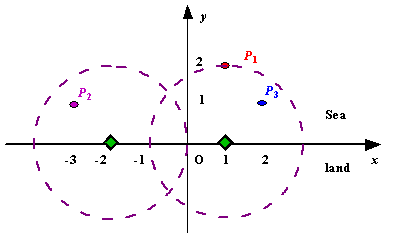Radar Installation
| Time Limit: 1000MS | Memory Limit: 10000K | |
| Total Submissions: 76872 | Accepted: 17220 |
Description
Assume the coasting is an infinite straight line. Land is in one side of coasting, sea in the other. Each small island is a point locating in the sea side. And any radar installation, locating on the coasting, can only cover d
distance, so an island in the sea can be covered by a radius installation, if the distance between them is at most d.
We use Cartesian coordinate system, defining the coasting is the x-axis. The sea side is above x-axis, and the land side below. Given the position of each island in the sea, and given the distance of the coverage of the radar installation, your task is to write a program to find the minimal number of radar installations to cover all the islands. Note that the position of an island is represented by its x-y coordinates.

Figure A Sample Input of Radar Installations
We use Cartesian coordinate system, defining the coasting is the x-axis. The sea side is above x-axis, and the land side below. Given the position of each island in the sea, and given the distance of the coverage of the radar installation, your task is to write a program to find the minimal number of radar installations to cover all the islands. Note that the position of an island is represented by its x-y coordinates.

Figure A Sample Input of Radar Installations
Input
The input consists of several test cases. The first line of each case contains two integers n (1<=n<=1000) and d, where n is the number of islands in the sea and d is the distance of coverage of the radar installation. This is
followed by n lines each containing two integers representing the coordinate of the position of each island. Then a blank line follows to separate the cases.
The input is terminated by a line containing pair of zeros
The input is terminated by a line containing pair of zeros
Output
For each test case output one line consisting of the test case number followed by the minimal number of radar installations needed. "-1" installation means no solution for that case.
Sample Input
3 2 1 2 -3 1 2 1 1 2 0 2 0 0
Sample Output
Case 1: 2 Case 2: 1
题意:一条海岸线,海岸线半边是海,半边是大陆,但在海上有许多岛,要求在海岸线上建立雷达,以至于可以检测到所有岛。给出所有岛的坐标和雷达检测的半径,求出最少用多少个雷达可以检测到所有岛。
思路;最开始的思路是按照岛的横坐标排序,然后从左边第一个岛依次遍历,求出可以检测到这个岛的雷达能检测到的所有岛,然后把这些岛标记为已检测,直到最后一个岛,看用了几个雷达,但这种思路超时了,也不太好优化,所以放弃了。后来一种思路是转化为相交区间问题,因为可以检测到的每个岛的雷达都会有一个区间范围,如果下一个岛的雷达区间与上一个岛有重合,则不用在加雷达,反之则再加一个雷达。
AC代码:
#include <iostream>
#include <algorithm>
#include <cmath>
#include <cstring>
#include <cstdio>
using namespace std;
struct node
{
double l;
double r;
}a[1005];
bool cmp(node a,node b)
{
return a.l<b.l;
}
int main()
{
//freopen("D://in.txt","r",stdin);
int num,n,d,y,T=1;
double dist,x;
while(~scanf("%d %d",&n,&d))
{
if(n==0&&d==0)
break;
bool flag=false;
if(d<=0)
flag=true;
for(int i=1;i<=n;i++)
{
scanf("%lf %d",&x,&y);
if(abs(y)<=d)
{
dist=sqrt(double(d*d-y*y));
a[i].r=x+dist;
a[i].l=x-dist;
}
else
flag=true;
}
if(flag)
{
printf("Case %d: -1\n",T++);
continue;
}
sort(a+1,a+n+1,cmp);
x=a[1].r;
num=1;
for(int i=2;i<=n;i++)
{
if(a[i].l>x)
{
num++;
x=a[i].r;
}
else
x=min(a[i].r,x);
}
printf("Case %d: %d\n",T++,num);
}
return 0;
}





















 1119
1119

 被折叠的 条评论
为什么被折叠?
被折叠的 条评论
为什么被折叠?








